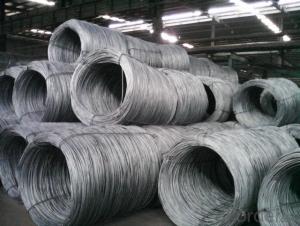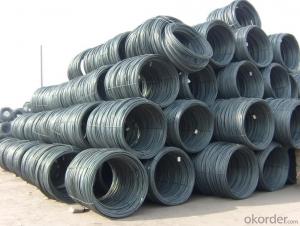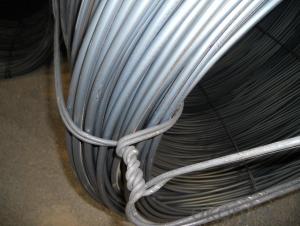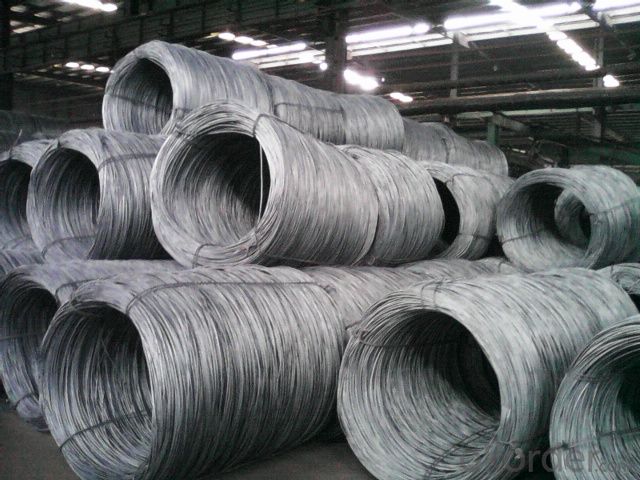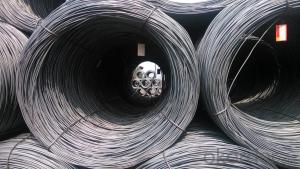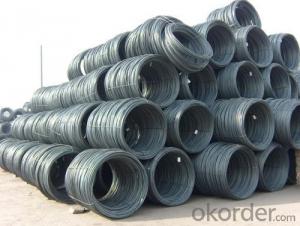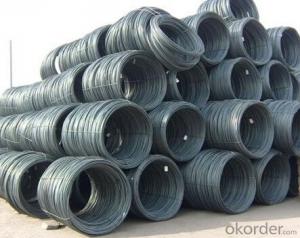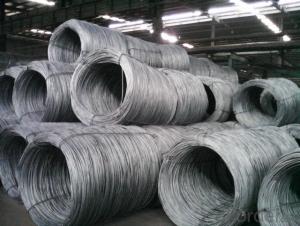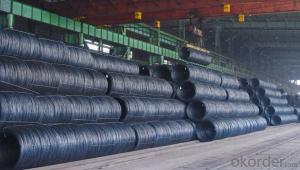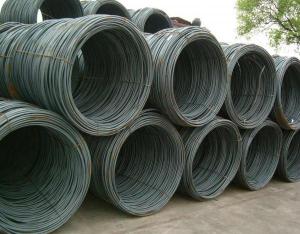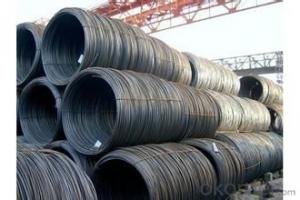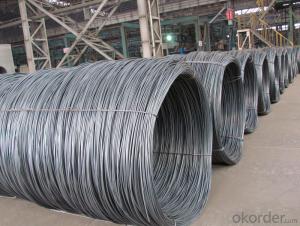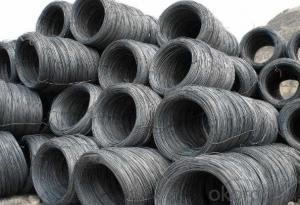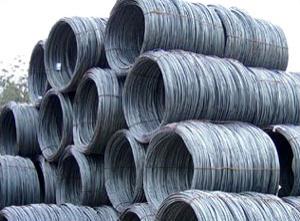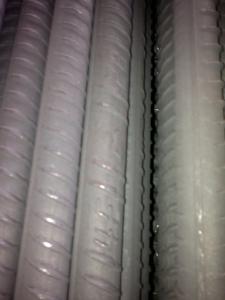Steel Wire Rod of Alloy Low Carbon Steel
- Loading Port:
- China main port
- Payment Terms:
- TT or LC
- Min Order Qty:
- 100 m.t.
- Supply Capability:
- 10000 m.t./month
OKorder Service Pledge
OKorder Financial Service
You Might Also Like
Specification
OKorder is offering Steel Wire Rod of Alloy Low Carbon Steel at great prices with worldwide shipping. Our supplier is a world-class manufacturer of steel, with our products utilized the world over. OKorder annually supplies products to African, South American and Asian markets. We provide quotations within 24 hours of receiving an inquiry and guarantee competitive prices.
Product Applications:
Steel Wire Rod of Alloy Low Carbon Steel are ideal for structural applications and are widely used in reinforcement of reinforced concrete and welded structure or reprocessed (roberts , nail, etc.) materials, especially used to produce wire drawing, welding electrode, nails, spring, electronic, precise machinery parts and so on.
Product Advantages:
OKorder's Steel Wire Rod of Alloy Low Carbon Steel are durable, strong, and wide variety of sizes.
Main Product Features:
· Premium quality
· Prompt delivery & seaworthy packing (30 days after receiving deposit)
· Can be recycled and reused
· Mill test certification
· Professional Service
· Competitive pricing
Product Specifications:
Steel Grade: Q195/235, SAE1006-1018B
Standard: ASTM, GB
Diameter: 5.5mm, 6.5mm, 7mm,8mm,9mm,10mm,12mm,14mm
Type: in coil, coil weight around 2MT
Alloy or Not: Alloy
Technique: Hot Rolled
Place of Origin: China Mainland
Surface: round, no twisted, light and smooth
Grade | Chemical Composition(%) | |||||
C | Mn | Si | S | P | B | |
SAE1006B | 0.03~O.07 | ≤0.32 | ≤0.30 | ≤0.045 | ≤0.040 | >0.0008 |
Mechanical properties | ||||||
Yield strength(N/mm2) | Tensile strength(N/mm2) | Elongation(%) | ||||
250-280 | 350-380 | ≥32 | ||||
Grade | Chemical Composition(%) | |||||
C | Mn | Si | S | P | B | |
SAE1008B | 0.10max | 0.3~O.50 | 0.15max | 0.050max | 0.040 max | 0.0008 min |
Mechanical properties | ||||||
Yield strength(N/mm2) | Tensile strength(N/mm2) | Elongation(%) | ||||
≥195 | 315-430 | ≥30 | ||||
Grade | Chemical Composition(%) | |||||
C | Mn | Si | S | P | B | |
Q195B | 0.06~O.12 | 0.25~O.50 | ≤0.30 | ≤0.050 | ≤0.045 | >0.0008 |
Mechanical properties | ||||||
Yield strength(N/mm2) | Tensile strength(N/mm2) | Elongation(%) | ||||
≥195 | 315-430 | ≥33 | ||||
Grade | Chemical Composition(%) | |||||
C | Mn | Si | S | P | B | |
Q235B | 0.12~O.2 | 0.3~O.701 | ≤0.30 | ≤0.045 | ≤0.045 | >0.0008 |
Mechanical properties | ||||||
Yield strength(N/mm2) | Tensile strength(N/mm2) | Elongation(%) | ||||
235 | 375-500 | ≥26 | ||||
FAQ:
Q1: Why buy Materials & Equipment from OKorder.com?
A1: All products offered byOKorder.com are carefully selected from China's most reliable manufacturing enterprises. Through its ISO certifications, OKorder.com adheres to the highest standards and a commitment to supply chain safety and customer satisfaction.
Q2: How do we guarantee the quality of our products?
A2: We have established an advanced quality management system which conducts strict quality tests at every step, from raw materials to the final product. At the same time, we provide extensive follow-up service assurances as required.
Q3: How many tons of steel products could be loaded in containers?
A3: Usually the steel products are delivered by bulk vessel because of the large quantity and the freight. However, there are no bulk vessel enter some seaports so that we have to deliver the cargo by containers. The 6m steel product can be loaded in 20FT container, but the quantity is changed according to the size, usually from 18tons to 25tons.
Images:

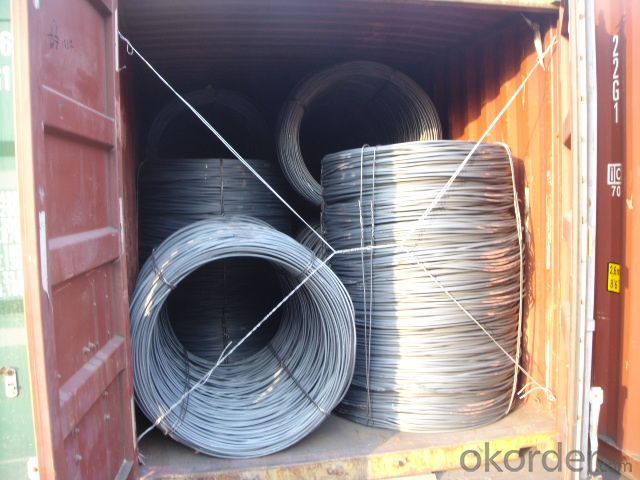
- Q: What are the different types of steel wire rod packaging options?
- There is a wide range of packaging options available for steel wire rods, each serving the purpose of ensuring secure transportation and storage, as well as facilitating convenient handling and loading. One popular packaging option is the coil, where steel wire rods are coiled and fastened with straps or bands to keep them in place. Coils are typically placed on wooden pallets or metal frames for added stability. This option is favored due to its compatibility with forklifts or cranes, making loading and unloading a breeze. Another packaging choice is the bundle method, in which steel wire rods are grouped together and secured with bands or straps. Bundles are often positioned on wooden pallets or metal frames for stability. This option is commonly utilized for smaller quantities of wire rods or rods with larger diameters. For larger quantities or heavier wire rods, hanks are employed as a packaging solution. In this method, the rods are twisted together to form a hank, which is then secured with bands or straps. Hanks are typically placed on wooden pallets or metal frames to ensure stability. In addition to coils, bundles, and hanks, drums and spools are also utilized for packaging steel wire rods. Drums are cylindrical containers capable of holding a substantial quantity of wire rods, while spools are smaller and designed to contain a specific length or weight of wire rods. Drums and spools are commonly constructed from metal or plastic materials, offering protection to the wire rods during transportation. The selection of a packaging option depends on various factors, including the quantity and size of the wire rods, transportation requirements, and customer preferences. Each packaging option boasts its own advantages in terms of ease of handling, protection of the wire rods, and cost-effectiveness.
- Q: What are the common packaging methods for steel wire rod?
- The common packaging methods for steel wire rod include coil packaging, bundle packaging, and pallet packaging. Coil packaging involves winding the wire rod into a coil shape and securing it with steel straps or plastic wraps. Bundle packaging involves grouping multiple wire rods together and securing them with steel straps or plastic wraps. Pallet packaging involves stacking multiple bundles or coils of wire rods on a pallet and securing them with straps or stretch film. These packaging methods ensure the safe transportation and storage of steel wire rods.
- Q: What are the different types of steel wire rod surface cleaning processes?
- Various industries commonly utilize different types of processes to clean the surface of steel wire rods. These processes aim to eliminate contaminants like rust, scale, dirt, and oil, ensuring that the wire rod is clean and ready for further use or processing. The most frequently employed steel wire rod surface cleaning processes are as follows: 1. Pickling: In this process, the wire rod is submerged in an acid solution, typically hydrochloric acid, to eradicate surface impurities. The acid reacts with the contaminants, dissolving them and leaving the wire rod clean. 2. Shot blasting: Shot blasting involves propelling abrasive particles, such as steel shots or grits, onto the wire rod's surface at high velocity. This abrasive action removes rust, scale, and other impurities, resulting in a clean and textured finish. 3. Wire brushing: Wire brushing is a mechanical process that utilizes wire brushes to scrub the wire rod's surface. This process effectively removes loose rust, dirt, and other contaminants. 4. Chemical cleaning: Chemical cleaning entails the application of specific chemical agents to the wire rod's surface. These agents react with the contaminants, breaking them down and facilitating their removal. 5. Ultrasonic cleaning: Ultrasonic cleaning employs high-frequency sound waves to generate microscopic bubbles in a cleaning solution. These bubbles implode on the wire rod's surface, creating a scrubbing action that eliminates contaminants. 6. Electrochemical cleaning: Electrochemical cleaning, also known as electrocleaning, employs an electric current to eliminate surface impurities from the wire rod. The wire rod is immersed in an electrolyte solution, and the electric current causes the contaminants to dissolve. Each of these steel wire rod surface cleaning processes possesses its own advantages and limitations. The selection of a process depends on factors such as the type and severity of contamination, the desired level of cleanliness, and the specific requirements of the application.
- Q: How is steel wire rod used in the production of wire ropes for cranes?
- Steel wire rod is a crucial component in the production of wire ropes for cranes. Wire ropes used in cranes require high tensile strength, durability, and flexibility to withstand heavy loads and frequent usage. Steel wire rods, which are typically produced from carbon steel or alloy steel, provide these necessary characteristics. The first step in the production of wire ropes involves the drawing process. Steel wire rods are drawn through a series of dies to reduce their diameter and increase their length. This process, known as cold drawing, not only refines the wire rod's surface finish but also enhances its tensile strength. By subjecting the wire rod to this process, it becomes thinner, longer, and stronger. After the cold drawing process, the wire rod is further processed to form individual wires. These wires are then helically laid around a core in a specific pattern, forming strands. The number and arrangement of strands depend on the desired strength and flexibility of the wire rope. The steel wire rod's high tensile strength ensures that the resulting wires and strands can withstand the considerable forces involved in crane operations. Once the strands are formed, they are carefully laid together around a central core to create the final wire rope. The steel wire rod's durability and flexibility allow the wire rope to withstand bending, twisting, and stretching without breaking or losing its shape. This is essential for cranes, as they often operate in harsh conditions and are subjected to repetitive cycles of heavy lifting. Additionally, the steel wire rod used in wire rope production undergoes various heat treatment processes to enhance its mechanical properties. This treatment modifies the steel's microstructure, increasing its strength and toughness. Heat treatment processes such as annealing, quenching, and tempering ensure that the wire rope can endure the demanding working conditions of cranes. In summary, steel wire rod plays a vital role in the production of wire ropes for cranes. Its high tensile strength, durability, and flexibility are crucial for withstanding heavy loads and frequent usage. The steel wire rod undergoes various processes such as cold drawing and heat treatment to enhance its mechanical properties, ensuring that the resulting wire rope can withstand the demanding operations of cranes.
- Q: What are the safety requirements for steel wire rod used in mining wire ropes?
- The safety requirements for steel wire rod used in mining wire ropes are crucial to ensure the safe and reliable operation of mining equipment. These requirements are necessary to prevent accidents, injuries, and fatalities that may occur due to the failure of wire ropes. 1. Material Composition: The steel wire rod used in mining wire ropes must be manufactured from high-quality steel with specific properties to withstand the demanding conditions in mining operations. It should have a high tensile strength, excellent fatigue resistance, and good ductility. 2. Strength and Durability: The wire rod should meet specific strength requirements to ensure it can handle the load and stress associated with mining activities. It must be able to withstand heavy loads, sudden impacts, and repetitive bending and flexing without showing signs of fatigue or failure. 3. Surface Quality: The surface of the steel wire rod should be smooth and free from any cracks, deformations, or defects that could compromise the integrity of the wire rope. A rough or uneven surface can lead to increased friction, wear, and potential failures during operation. 4. Dimensional Accuracy: The wire rod should adhere to precise dimensional tolerances to ensure compatibility with other components of the wire rope system. Accurate dimensions are necessary for proper assembly, fitting, and functionality of the wire rope. 5. Heat Treatment: Proper heat treatment processes, such as annealing or quenching, should be applied to the wire rod to enhance its mechanical properties. Heat treatment can improve the strength, hardness, and resistance to wear and corrosion, making the wire rope more reliable and durable. 6. Quality Control: Rigorous quality control measures should be implemented during the manufacturing process to ensure the wire rod meets the specified safety requirements. Regular inspections, testing, and certifications should be carried out to verify the material's compliance with industry standards and regulations. 7. Documentation and Traceability: It is essential to maintain accurate documentation and traceability records for the steel wire rod used in mining wire ropes. This allows for proper tracking of the material's origin, manufacturing process, and quality control procedures, ensuring accountability and facilitating any necessary investigations or recalls. Adhering to these safety requirements for steel wire rod used in mining wire ropes is crucial to maintaining the integrity and reliability of the equipment. Regular inspection and maintenance of the wire ropes should also be conducted to ensure their continued safe operation.
- Q: What are the different types of steel wire rod surface inspection techniques?
- There are several types of steel wire rod surface inspection techniques, including visual inspection, magnetic particle inspection, ultrasonic testing, eddy current testing, and dye penetrant inspection.
- Q: How is steel wire rod used in the production of wire mesh reinforcement?
- Steel wire rod is an essential component in the production of wire mesh reinforcement. It serves as the main raw material for manufacturing wire mesh, which is widely used in construction and other industries for reinforcing concrete structures. To produce wire mesh reinforcement, steel wire rod is first processed through a series of manufacturing steps. The rod is typically drawn through a series of dies to reduce its diameter and increase its length. This process, known as wire drawing, results in a thinner and longer wire with improved mechanical properties. The drawn wire is then fed into a specialized machine called a wire mesh welding machine. This machine uses electric resistance welding to join the wires together, forming a grid-like pattern. The welding process ensures that the wires are securely bonded at their intersections, creating a sturdy and durable wire mesh. The wire mesh reinforcement is used in various construction applications, such as in the construction of concrete slabs, walls, and columns. It is embedded in concrete structures to provide additional strength, prevent cracking, and increase the overall load-bearing capacity. The wire mesh acts as a reinforcement, distributing the forces and stresses evenly across the concrete, thereby enhancing its structural integrity. Furthermore, wire mesh reinforcement is also utilized in other industries, including agriculture, mining, and manufacturing. In agriculture, it is commonly used as fencing to secure livestock and crops. In mining, wire mesh is employed for safety purposes, such as preventing rockfalls and supporting tunnel walls. In manufacturing, wire mesh is utilized for filtration, separation, and containment purposes, among others. In summary, steel wire rod plays a crucial role in the production of wire mesh reinforcement. Its transformation through wire drawing and subsequent welding forms the basis for creating durable and versatile wire mesh. This reinforcement is widely used in construction and other industries to enhance the strength and integrity of various structures.
- Q: How are steel wire rods used in the production of screws and bolts for construction?
- Steel wire rods are an essential component in the production of screws and bolts for construction purposes. These rods serve as the raw material for manufacturing these fasteners. To begin with, steel wire rods are first processed through a series of manufacturing steps. They are initially drawn through a series of dies to reduce their diameter and increase their length. This process is known as wire drawing, and it helps in achieving the desired size and strength of the wire rod. Once the wire rods are drawn to the required dimensions, they are then cut into smaller lengths that are suitable for the production of screws and bolts. These lengths are often referred to as blanks or billets. The next step involves the threading of these blanks to create the screw or bolt shape. This threading process is typically done using specialized machines that cut or roll grooves onto the surface of the wire rods. These grooves are what enable the screws and bolts to effectively grip into their respective materials, providing a secure connection. After the threading process, the blanks are further processed to add various features, such as the head shape, drive type (such as slotted, Phillips, or hex), and any additional coatings or finishes required for corrosion resistance. This is typically done through machining or forging processes, depending on the desired specifications of the screws and bolts. Once the screws and bolts are formed, they undergo quality control checks to ensure that they meet the necessary standards for strength, dimensions, and overall functionality. This includes testing for factors like tensile strength, hardness, and dimensional accuracy. Finally, the screws and bolts are packaged and distributed for use in construction projects. These fasteners play a crucial role in joining various components of a structure together, providing stability, strength, and longevity to the overall construction. They are widely used in applications such as framing, fastening walls, securing beams, and connecting various building materials. In summary, steel wire rods are used in the production of screws and bolts for construction by serving as the raw material that is processed, threaded, and shaped into fasteners with specific features and properties. These fasteners are vital for the structural integrity and reliability of construction projects, making steel wire rods a crucial component in the construction industry.
- Q: What are the major opportunities for companies in the steel wire rod market?
- Some major opportunities for companies in the steel wire rod market include expanding into emerging economies with growing construction and infrastructure sectors, diversifying product offerings to cater to various industries such as automotive and aerospace, embracing technological advancements to improve production efficiency and quality, and exploring sustainable practices to meet the growing demand for environmentally friendly steel products.
- Q: What are the different types of steel wire rod surface defect monitoring and reporting tools?
- Some of the different types of steel wire rod surface defect monitoring and reporting tools include optical inspection systems, eddy current testing, ultrasonic testing, and magnetic particle inspection. These tools help to identify and report surface defects such as cracks, pits, and surface irregularities in wire rods.
Send your message to us
Steel Wire Rod of Alloy Low Carbon Steel
- Loading Port:
- China main port
- Payment Terms:
- TT or LC
- Min Order Qty:
- 100 m.t.
- Supply Capability:
- 10000 m.t./month
OKorder Service Pledge
OKorder Financial Service
Similar products
Hot products
Hot Searches
Related keywords
